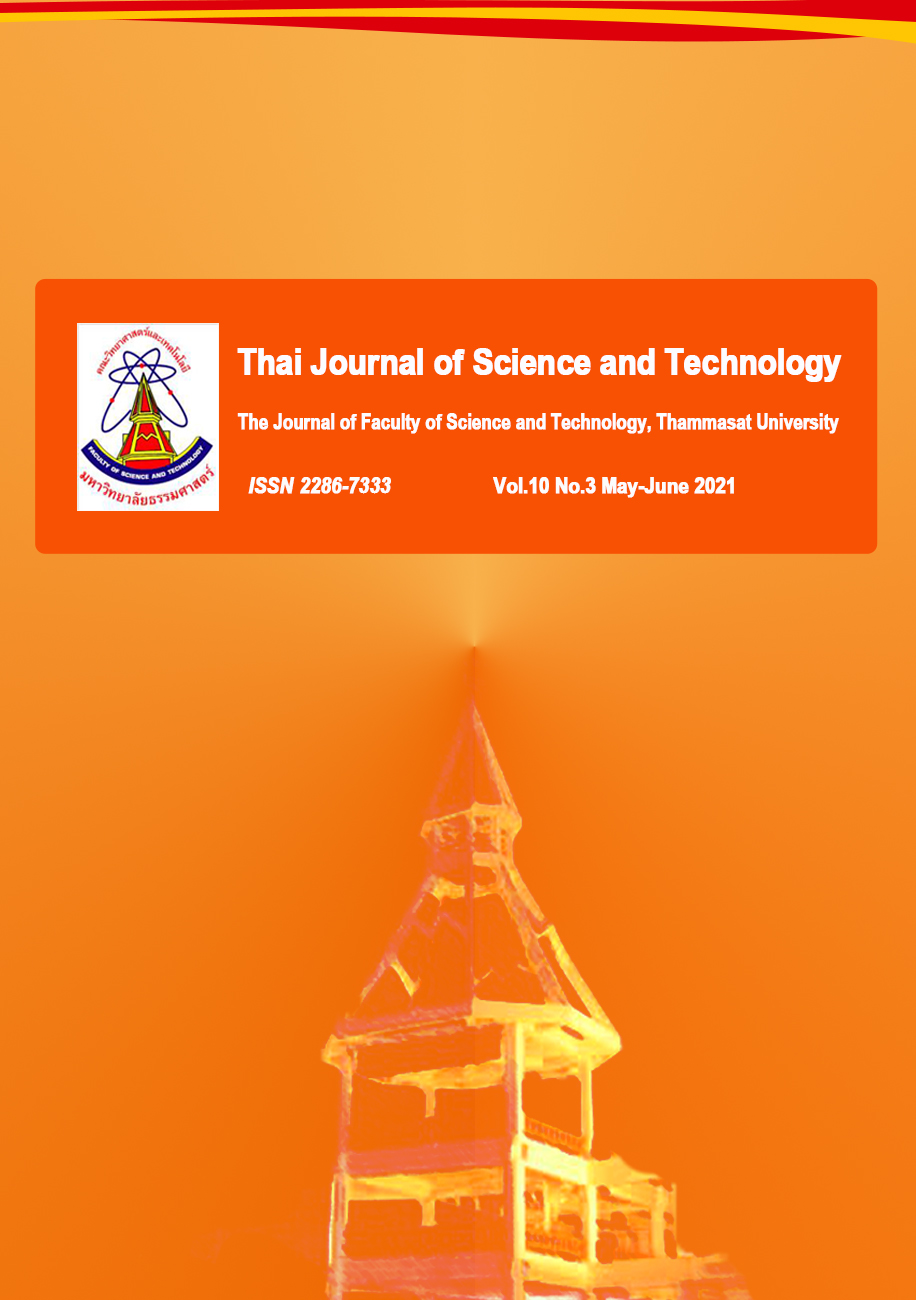Effects of Red Light and 6-Benzyladenine on Branching and Flowering in Cassava
Main Article Content
Abstract
Flowering induction is one of the most important processes in plant breeding. This study aimed to assess cassava flowering response under the induction of red light and/or 6-benzyladenine (BA) with silver thiosulfate (STS). A split-plot in randomized complete block design with four replications was used for this study. The main plot factor was cassava flowering induction, which were (1) control, (2) spraying 0.5 mM BA with 2 mM STS, (3) spraying 0.5 mM BA with 2 mM STS and red light, and (4) red light with a wavelength of 620 nm at night. Sub-plot factor was cassava variety, including ADIRA 4, Huaybong 90, Kasetsart 50, Rayong 9, and TME3. Data of growth and traits, including the first branching height, total height, and the proportion of the first branching height to total height at age 4, 5, and 9 months after planting, were collected. Flowering traits were collected as the number of male flowers per bunch, the number of female flowers per bunch and the number of bunches per plant of cassava at 5, 6, 7, and 9 months after planting. The result showed that the methods of flowering induction did not cause significant differences in the flowering traits. The use of red light and BA resulted in increasing height and branching ratio. However, this change did not affect the flowering traits of cassava.
Article Details

This work is licensed under a Creative Commons Attribution-NonCommercial-NoDerivatives 4.0 International License.
บทความที่ได้รับการตีพิมพ์เป็นลิขสิทธิ์ของคณะวิทยาศาสตร์และเทคโนโลยี มหาวิทยาลัยธรรมศาสตร์ ข้อความที่ปรากฏในแต่ละเรื่องของวารสารเล่มนี้เป็นเพียงความเห็นส่วนตัวของผู้เขียน ไม่มีความเกี่ยวข้องกับคณะวิทยาศาสตร์และเทคโนโลยี หรือคณาจารย์ท่านอื่นในมหาวิทยาลัยธรรมศาสตร์ ผู้เขียนต้องยืนยันว่าความรับผิดชอบต่อทุกข้อความที่นำเสนอไว้ในบทความของตน หากมีข้อผิดพลาดหรือความไม่ถูกต้องใด ๆ
References
Adeyemo, O.S., Hyde, P.T., & Setter, T.L. (2019). Identification of FT family genes that respond to photoperiod, temperature and genotype in relation to flowering in cassava (Manihot esculent, Crantz). Plant Reproduction, 32(2), 181-191.
Bernier, G., Kinit, J.M., & Sachs, R.M. (1985). The Physiology of Flowering (Vol. 2). Transition to Reproductive Growth. CRC Press: Florida.
Cho, L.H., Yoon, J., & An, G. (2017). The control of flowering time by environmental factors. The Plant Journal, 90(4), 708-719.
Gardner, F.P., Pearce, R.B., & Mitchell, R.L. (2017). Physiology of Crop Plants. (2nd eds). Iowa State University Press, Ames, IA, USA.
Office of Agricultural Economics. (2018). Agricultural Statistics of Thailand 2018. Retrieved from http://www.oae.go.th (in Thai)
Oluwasanya, D.N., Esan, O.C., Hyde, P.T., Kulakow, P., & Setter, T.L. (2020). Silver thiosulfate and Benzyladenine in combination with pruning additively feminize cassava flowers and modulate transcriptome. bioRxiv, 2020,12 ,15, 422940.
Pineda, M., Morante, N., Salazar, S., Cuásquer, J., Hyde, P.T., Setter, T.L., & Ceballos, H. (2020). Induction of earlier flowering in cassava through extended photoperiod. Agronomy, 10(9), 1273.
Salairuk, K. (2010). Photoperiodic induction of flowering of Chinese sacred lotus (Nelumbo nucifera Gaertn.) and response of growth and grain yield in Thai x Chinese hybrids. (Master's Degree). Kasetsart University, (in Thai).
Sawatdisan, C. (2007). Effects of light intensity, photoperiod, cytokinin, gibberellin, and ethylene on off-season flowering of dragon fruit (Hylocereus undatus (Haw.) Britt). (Master's Degree). Kasetsart University, (in Thai).
Thongampai, P. (1986). Plant Hormones and Plant Growth Regulator Usage Guidelines in Thailand. Dynamic Printing Part., Ltd. (in Thai).


